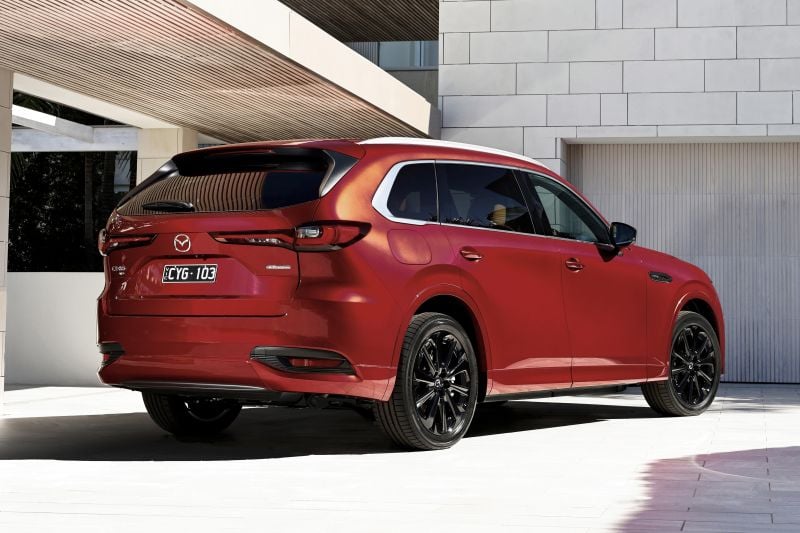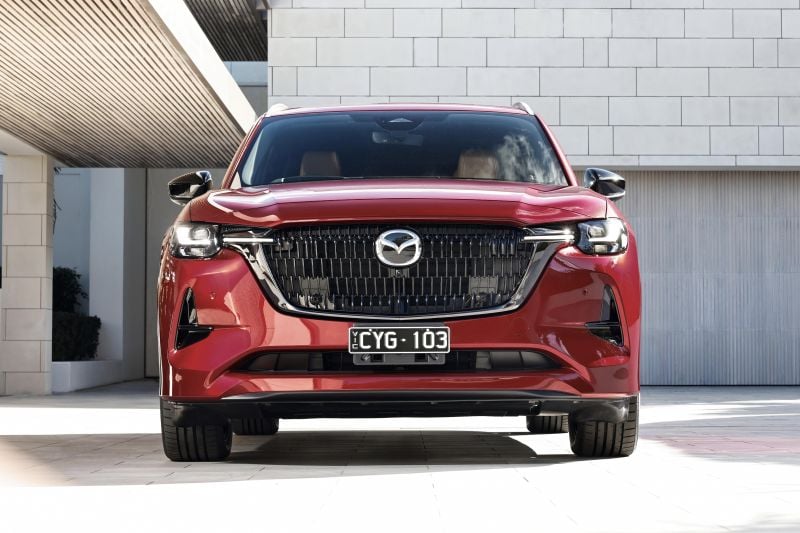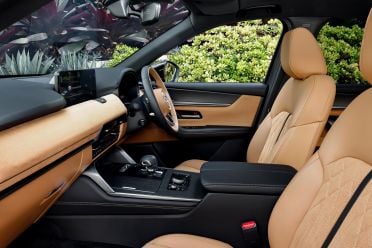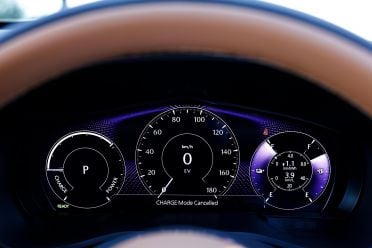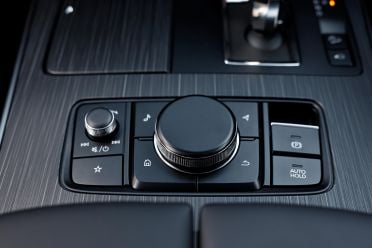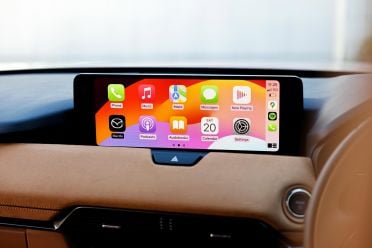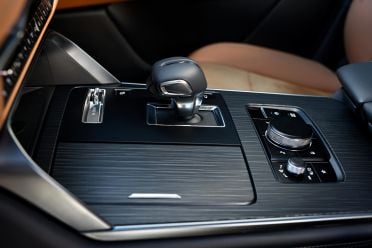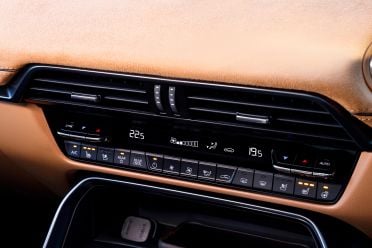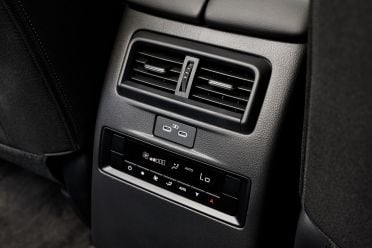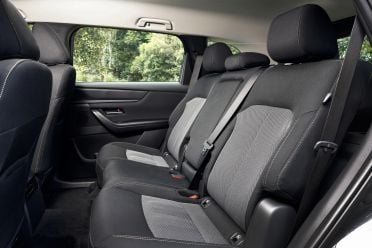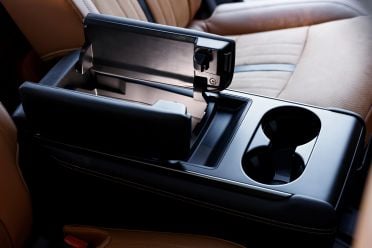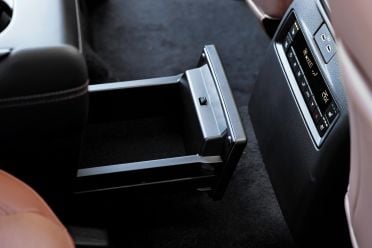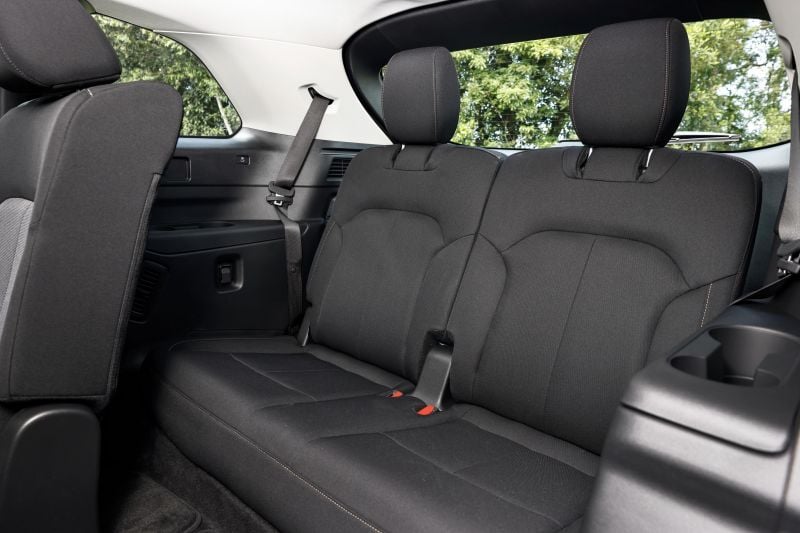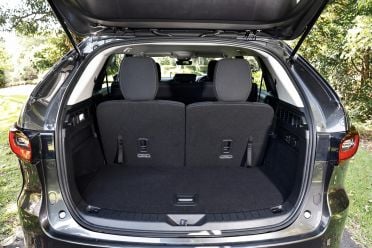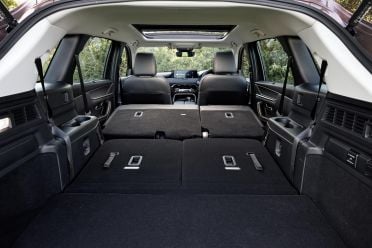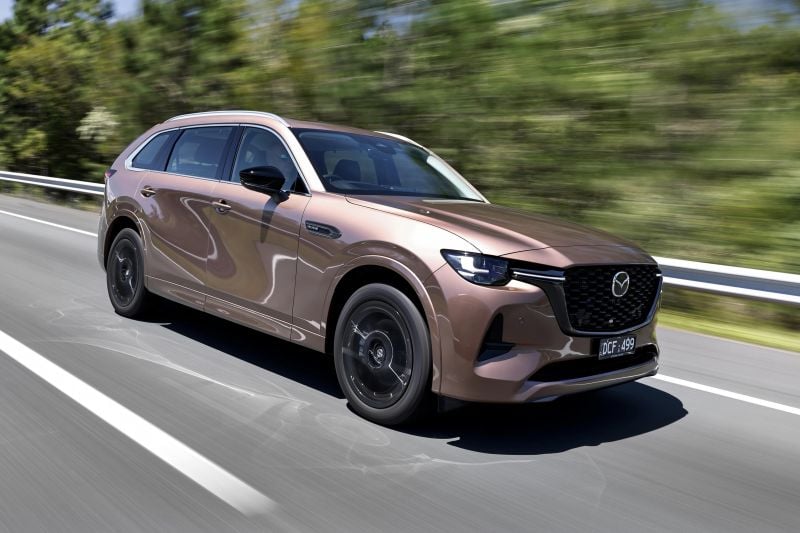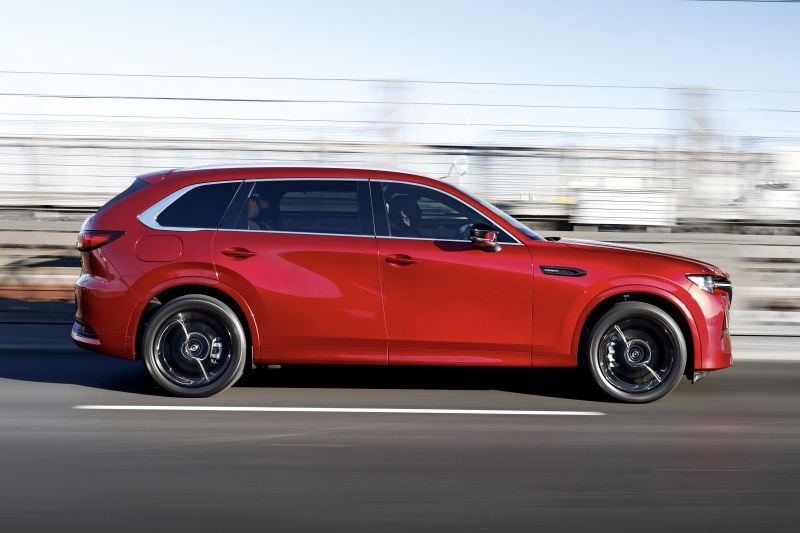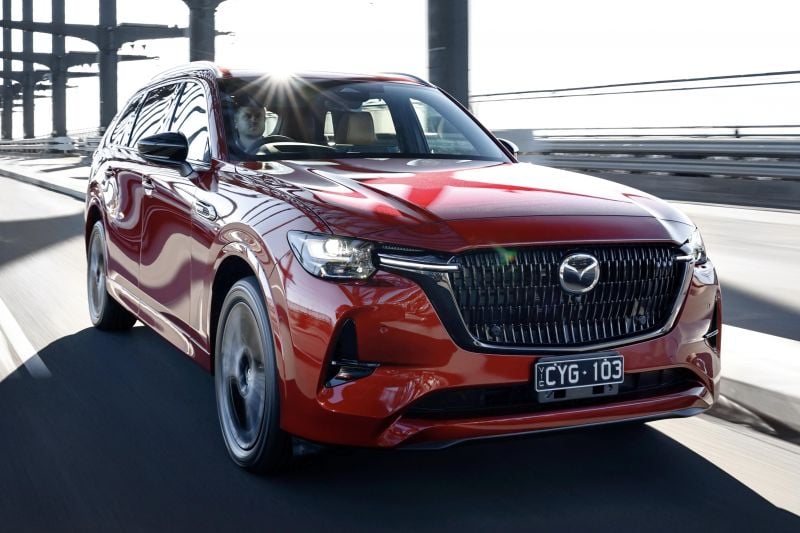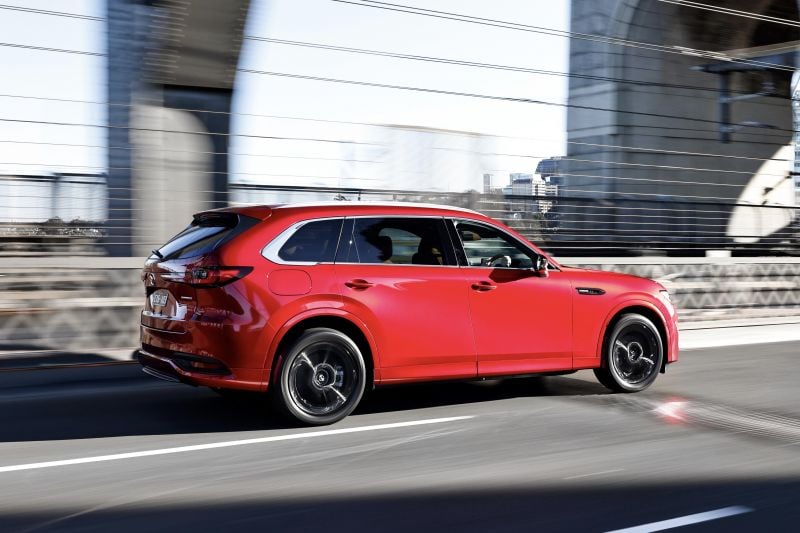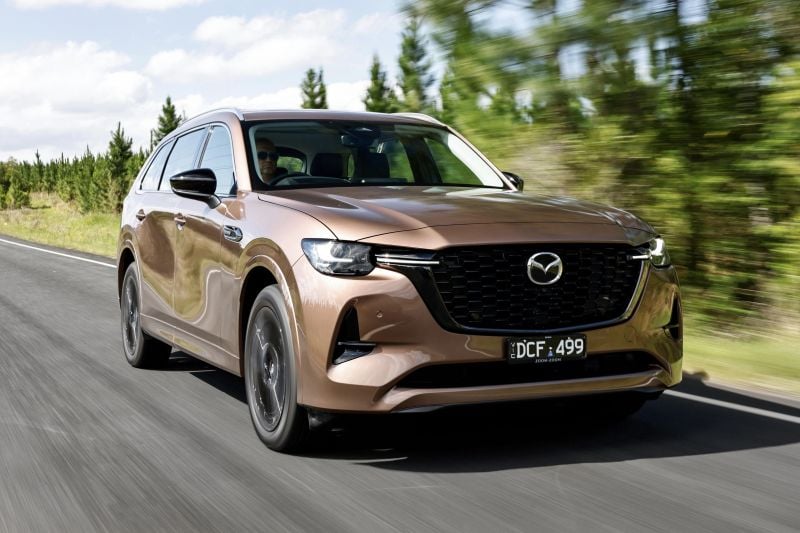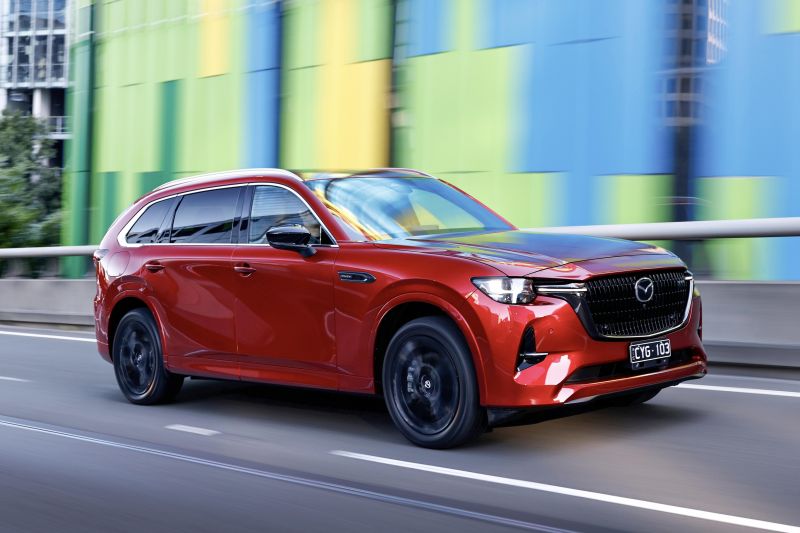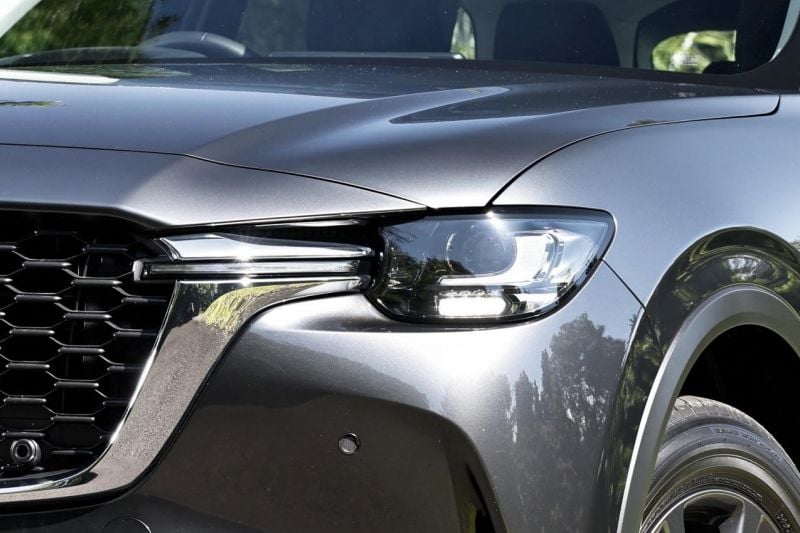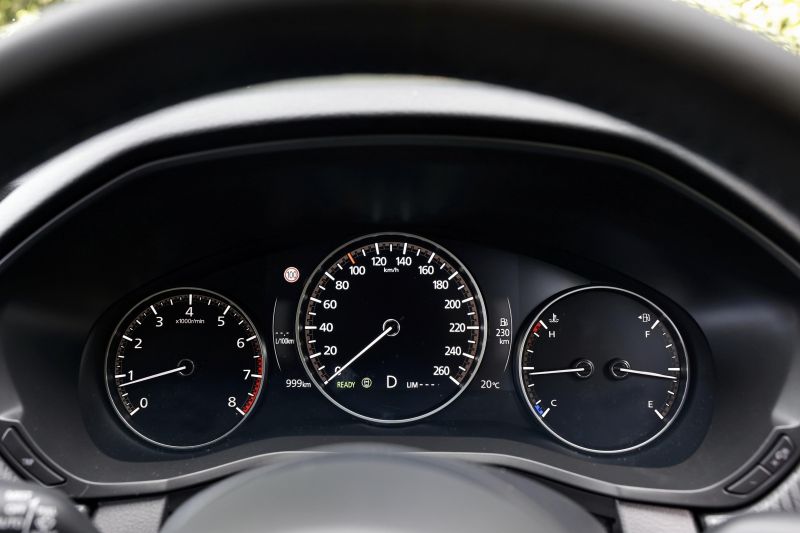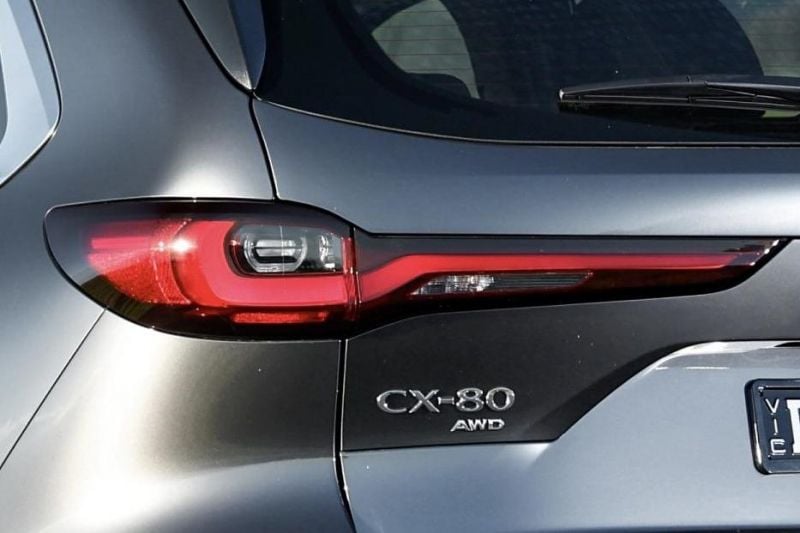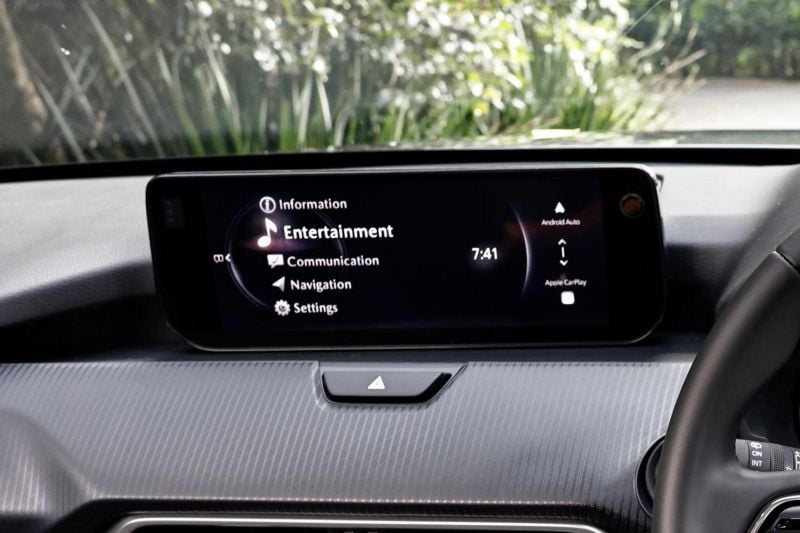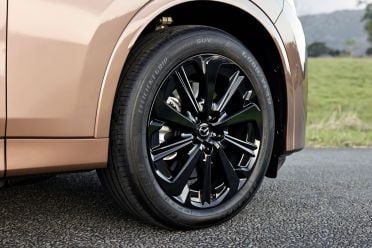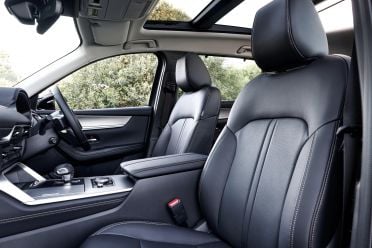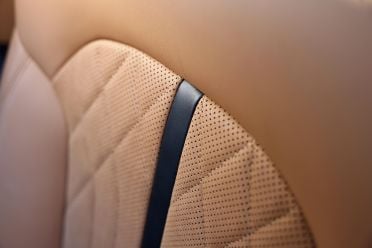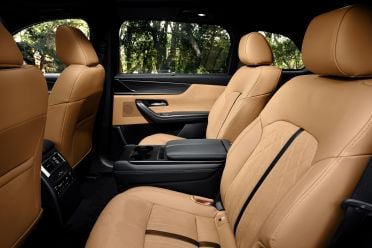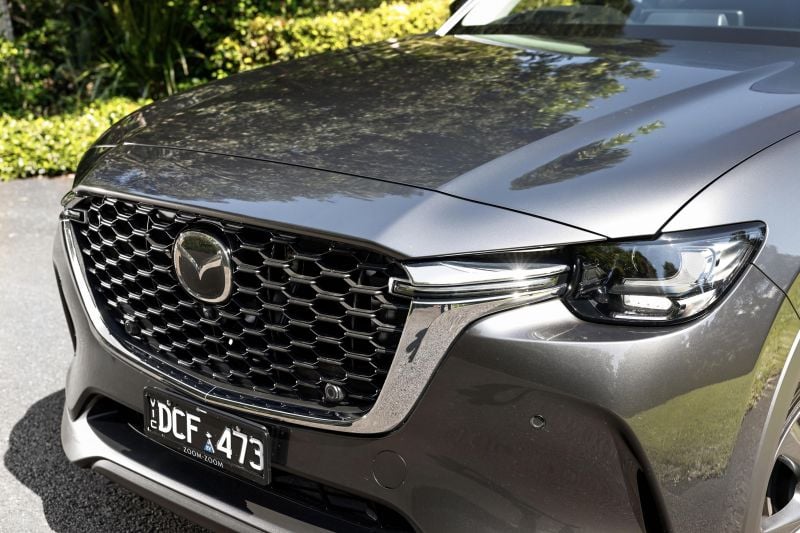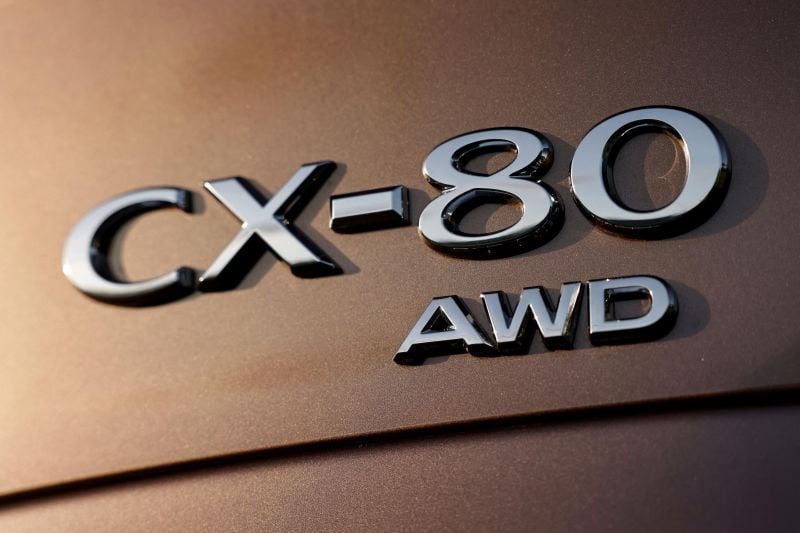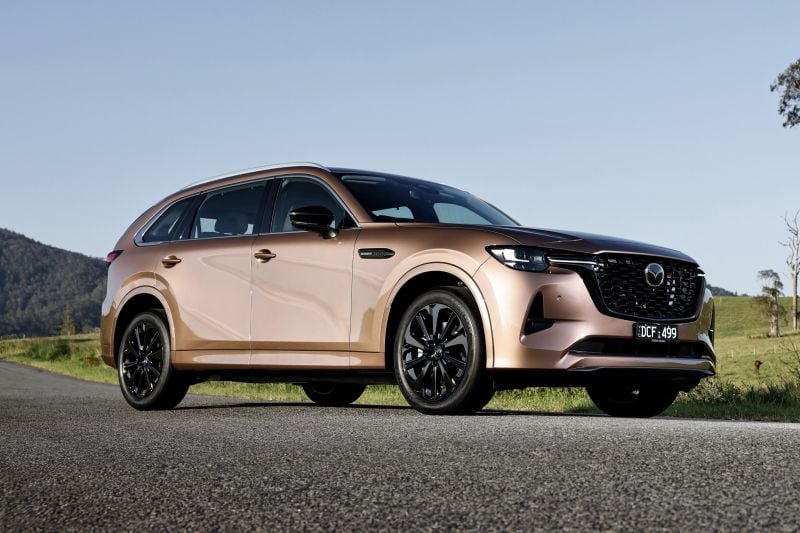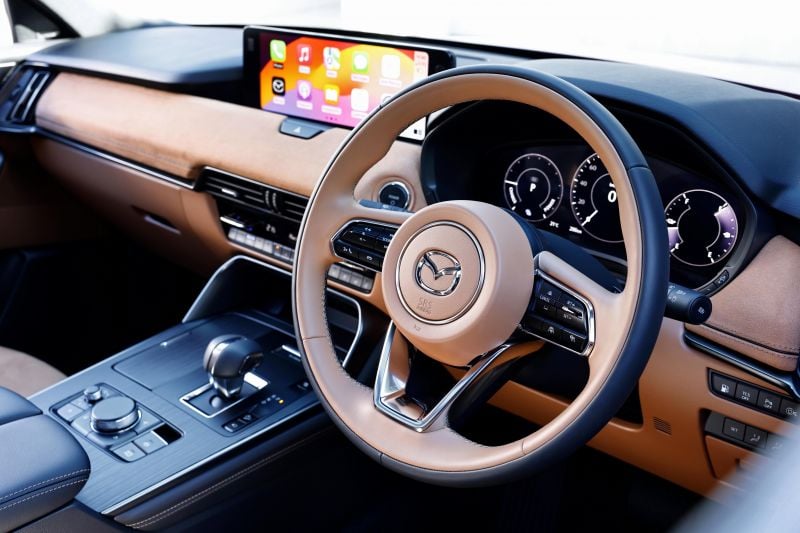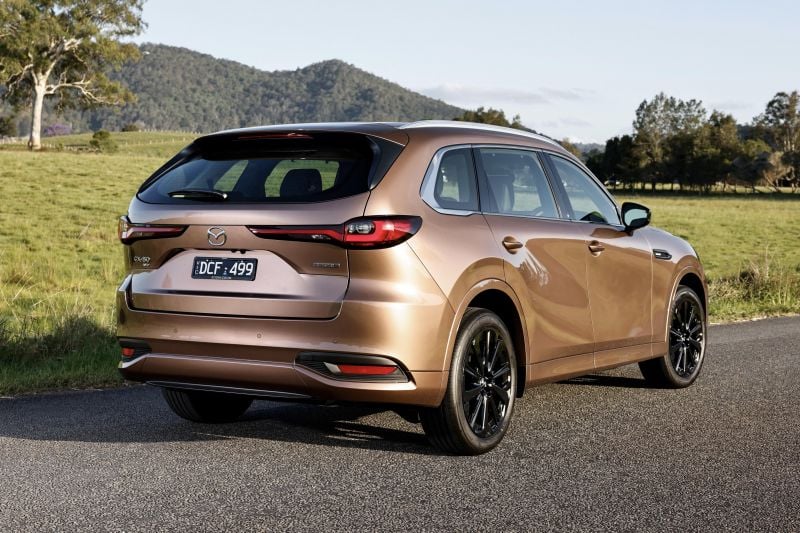Mazda’s newest seven-seat large SUV has just arrived Down Under, and there’s a lot to be interested in.
The Mazda CX-80 joins the CX-90 in the Japanese brand’s local large SUV range (effectively replacing the now-discontinued CX-8 and CX-9) alongside the equally new CX-70 five-seater, and while it’s very much a stretched version of the five-seat CX-60 mid-sized SUV, there are some key differences.
The first is it adds seven-seat capacity on account of its lengthened wheelbase, without drastically changing the way it drives or behaves on the road.
The second is price, because it actually undercuts the CX-60 at the bottom of the range. It’s listed at less than $55,000 before on-road costs, which makes it over $5000 more affordable than the smaller CX-60 at base level.
It’s all very promising, and Mazda seems to think so too – the brand has forecast a sales target of 650 a month, which is more than the CX-60 at 550.
WATCH: Alborz’s video review of the 2025 Mazda CX-80
The CX-80 is joining the Australian Mazda range as a rival to other large three-row SUVs like the Kia Sorento, Hyundai Santa Fe, and Toyota Kluger. It’s cheaper than the latter two as well, though it’s still undercut by the Sorento.
With four distinct trim levels and three different powertrains including a plug-in hybrid (PHEV), there’s plenty to choose from to ensure you get your hands on the CX-80 that best suits your needs.
We’ve now had the opportunity to test the new CX-80 range at its national media launch in Brisbane. Is the CX-80 deserving of Mazda’s bold sales ambitions, or will it get lost in the sea of large SUVs?

How much does the Mazda CX-80 cost?
There are a total of 10 variants in the CX-80 range, but while the entry price is sharp, all of them are more expensive than their direct Sorento rivals.
However, the base-spec Pure is cheaper than the equivalent Kluger and the Santa Fe, while offering an arguably nicer interior.
At $54,950 before on-road costs, the cheapest CX-80 variant in particular is a tempting offering, especially because it undercuts the related Mazda CX-60 while adding more metal and two extra seats.
Additionally, the SP Package (detailed below) is available on Azami variants only for an extra $5000.
| Model | Price before on-road costs |
|---|---|
| 2025 Mazda CX-80 G40e Pure | $54,950 |
| 2025 Mazda CX-80 G40e Touring | $61,950 |
| 2025 Mazda CX-80 D50e Touring | $63,950 |
| 2025 Mazda CX-80 G40e GT | $68,950 |
| 2025 Mazda CX-80 D50e GT | $70,950 |
| 2025 Mazda CX-80 G40e Azami | $74,150 |
| 2025 Mazda CX-80 P50e Touring | $75,000 |
| 2025 Mazda CX-80 D50e Azami | $76,150 |
| 2025 Mazda CX-80 P50e GT | $82,000 |
| 2025 Mazda CX-80 P50e Azami | $87,200 |
To see how the Mazda CX-80 stacks up against its rivals, use our comparison tool.
What is the Mazda CX-80 like on the inside?
As one may hope from an SUV of this size and price point, the interior Mazda offers across its whole CX-80 range is undeniably classy.
Naturally, there are some differences depending on the variant. Starting from the bottom with the base-level Pure, you’ll notice many of the cabin’s surfaces are finished in durable, hard plastic, though there are some nicer touches like the leather-clad steering wheel and armrests.
The seats are upholstered in cloth and the headliner is grey, but in the middle of the car is a smaller 10.25-inch version of the touchscreen infotainment system found in the CX-80’s more expensive variants – which is still a quality unit.
Below that is also Mazda’s typical climate control interface; headlined by an array of physical buttons and switches. In the Pure there are a handful of button blanks on either side, which are swapped out for buttons to control seat heating and ventilation as you move up the range.
Beyond the textured plastic on the dash, everything is as simple as can be, with hardly any embellishments outside of some metallic silver trim pieces scattered around.
The biggest difference in the Pure is the instrument cluster, which features two analogue gauges and a central display designed to look like a gauge. It’s very similar to what you’d find in a Mazda 3, which we liked there and still like here – though it feels a bit cheap in a car like the CX-80.
The Pure’s manual seat adjustment and cloth upholstery are swapped for power and leather respectively when you move up to the Touring. To its benefit, the CX-80 offers USB-C ports in the centre console storage box and wireless Apple CarPlay and Android Auto on all variants.
Seat heating for the front row is also added, while only the PHEV P50e version of the Touring offers a 12.3-inch digital infotainment cluster.
Many of the same features are carried over for the GT, which is where we feel the CX-80 hits its stride.
You gain a heated steering wheel, heated second-row seats, a 12.3-inch infotainment display, 12.3-inch digital instrument cluster, and a 12-speaker Bose-branded sound system.
It’s all very nice, and it gets better when you look up and see that panoramic sunroof. Unfortunately, it is broken up by a horizontal beam and doesn’t stretch the whole length of the roof, which is understandable given the real estate up there.
The infotainment system is the same setup as in many other new Mazdas using the current generation of hardware.
That’s to say it’s controlled by a central dial and buttons, and while others may dislike that setup I find it satisfying. I like being able to lean on the central armrest and flick through the screen using the dials, as sometimes it can be a stretch to reach the screen.
The main gripe people tend to have with Mazda’s approach is that the screen can’t be used as a touchscreen while on the move, and that the native software doesn’t support touchscreen functionality.
That’s at least partly solved in the CX-80, because the top-spec Azami allows you to use the touchscreen function with Apple CarPlay while on the move. If Mazda is going to allow touchscreen functionality anywhere in its multimedia system, CarPlay is the best place to do it given how clunky it can be otherwise.
It makes the system much easier to use, and it’s a solution for people who may be turned off by the dial.
It’s also worth noting the Touring is the first CX-80 variant to start above $60,000, and is $7000 more expensive than the single Pure grade.
Moving away from the Pure does unlock all those features and the option of diesel and PHEV powertrains, which brings significant value despite the price hike.
Of course, it’s all very similar to the CX-60, which has been on sale in Australia for some time, and which offers the same features like that semi-analogue instrument cluster and cloth upholstery.
The areas in which the CX-80 sets itself apart are twofold. One is the price, which undercuts the CX-60 by more than $5000 at the bottom of the range.
The other is space in the rear. In the CX-80 you’ll find three rows of seats, and the rearmost pair is surprisingly spacious as a result of the wheelbase extension over the CX-60 – a 250mm increase, to be exact.
To the benefit of third-row passengers in the CX-80, all variants receive the same creature comforts like rear air vents, cupholders and USB-C charging ports on either side. Equally, the seats are easy to erect or fold away, and the second-row seats can slide forward to allow access to the rear.
That second-row seating configuration changes depending on the variant. On the Pure, Touring, and GT, it’s a three-person bench seat and features typical amenities like a fold-down centre armrest with cupholders.
The Touring and GT feature heating, but the most drastic switch-up comes with the top-spec Azami – in which capacity is traded for luxury when the optional SP Package is selected. Where the other three variants offer seven-seat capacity, the Azami SP ‘downgrades’ to six seats as a result of its second-row captain’s chairs.
We’ve seen such chairs in the seven-seat CX-90, though that variant is intended to be the pinnacle of Mazda’s SUV range. The CX-80 is instead expected to be the volume-seller, and the captain’s chairs are a prime example of how Mazda has bolstered the range’s versatility even if they are part of a $5000 package.
The captain’s chairs in the CX-80 come at a cheaper price than in the CX-90, but you still get ventilation alongside heating. On top of all that, the central seat is replaced by additional storage that features a hidden drawer underneath.
It’s all intended to give passengers in the second row as much space as possible, which may be a strength for families that want the room to spread out.
Another selling point for the second row is the climate control system with rear-facing air vents, which are standard across the range.
The setup may chop and change depending on whether the variant has seat heating or ventilation, but a positive is that it’s always going to be there.
Above that are two USB-C charging ports too, and you’ll find bottle holders in the doors for some added storage. The seat backs each come with map pockets, and on the roof there’s black headlining that provides a more luxurious feel.
The particular Azami we drove featured a tan interior with black accents, which is the headline feature of the SP Package that Mazda offers on many of its vehicles.
It’s still trimmed in nappa leather upholstery, and that colourway is simply an option for further customisation. Beyond the captain’s chairs it’s largely cosmetic, with exterior tweaks including 20-inch black alloy wheels, a revised honeycomb grille, LED headlights, and black accents all around.
The Azami is the only CX-80 for which the SP Package is available; it’s otherwise offered with black Nappa leather upholstery and a standard three-seat second-row bench.
The SP Package’s black plastic trim is also a bonus over the standard silver paneling, which can look a bit cheap for a top-spec large SUV.
In contrast, it’s likely the SP Package (or even the Azami) won’t be the pick for young families, given the quality of the materials used, whereas the Pure and Touring in particular offer much harder-wearing setups that will better withstand children.
Opening the boot – which is powered in all variants except the Pure – reveals a versatile and functional space.
It’s large, and while having the third row in place eats into space dramatically, there’s still enough to fit a load of groceries or some smaller luggage items. The third row also folds flat into the floor to provide as much space as possible.
On either side of the boot is a selection of charging facilities. On all variants you’ll find dual 150W AC power outlets and a 12V auxiliary power outlet, while PHEV variants add a secondary 1500W AC outlet.
Additionally, there’s a light on the left-hand side and a selection of cargo hooks. Under the floor is enough space to store the cargo cover when not in use, as well as room for the charging cables in PHEV models.
However, there’s no spare wheel available in any CX-80 variant – not even a space-saver. Instead, there’s a tyre repair kit, which is hardly appropriate for a large SUV.
Otherwise, interior quirks are kept to a minimum, and it’s a highly usable space with plenty to keep you and your passengers both entertained and comfortable while on the move.
| Dimensions | Mazda CX-80 |
|---|---|
| Length | 4990mm |
| Width | 1949mm (mirrors folded) 2134mm (mirrors extended) |
| Height | 1710mm |
| Wheelbase | 3120mm |
| Boot space | 258L (incl. underfloor storage; to height of seatback) 566L (with third row folded) 1971L (with second and third row folded, measured to roof) |
To see how the Mazda CX-80 stacks up against its rivals, use our comparison tool.
What’s under the bonnet?
There are three powertrains available across the range, and all three of them are offered in all variants except the base Pure, which is petrol-only. Because we cycled through many of them at the launch, we were unable to record meaningful fuel consumption figures (see claimed figures below).
| Specifications | G40e | D50e | P50e |
|---|---|---|---|
| Powertrain | 3.3L turbo-petrol inline-six | 3.3L turbo-diesel inline-six | 2.5L four-cylinder |
| Electrification | 48V mild-hybrid | 48V mild-hybrid | Plug-in hybrid |
| Transmission | Eight-speed auto | Eight-speed auto | Eight-speed auto |
| Drive type | All-wheel drive | All-wheel drive | All-wheel drive |
| High-voltage battery | – | – | 17.8kWh lithium-ion |
| Total power | 209kW | 187kW | 241kW |
| Total torque | 450Nm | 550Nm | 500Nm |
| Electric range | – | – | 65km |
| AC charging rate | – | – | 7.2kW |
| Fuel economy (claim) | 8.4L/100km | 5.2L/100km | 2.7L/100km |
| CO2 emissions | 197g/km | 137g/km | 64g/km |
| Fuel tank size | 74L | 74L | 70L |
| Fuel type | 91 RON regular unleaded | Diesel | 95 RON premium unleaded |
| Braked towing capacity | 2500kg | 2000kg | 2500kg |
| Payload | 579kg | 579kg | 579kg |
| Kerb weight | 2084-2114kg | 2099-2130kg | 2500kg |
To see how the Mazda CX-80 stacks up against its rivals, use our comparison tool.
How does the Mazda CX-80 drive?
The CX-80 is a big, tall wagon, but because it’s basically a stretched version of the CX-60, it’s not as wide as the CX-90 (nor the CX-70), and it never feels unwieldy or intimidating.
Its large proportions make the CX-80 a great long-distance tourer on the open road, with solid refinement and well-weighted steering, but that doesn’t mean it struggles in built-up areas or in tight spaces.
Mazda quotes a turning circle of 11.6 metres, and it’s surprising just how tight it can turn for its size. Manoeuvrability is a strength, while the light steering at low speeds also means you’ll have no trouble navigating carparks.
The largest differences you’ll find across the range have to do with the powertrains. All non-PHEV CX-80s are mild-hybrid, which brings some fuel-saving benefits on paper but is otherwise hard to notice.
You can’t drive the CX-80 in electric-only mode unless it’s a PHEV, but you may sometimes feel a slight stumble as the car moves away from a stop.
Mated to all of the CX-80 engines is Mazda’s eight-speed Skyactiv-Drive automatic transmission, which is said to combine “the best attributes of conventional automatics with those of continuously variable and dual clutch transmissions”, though in general terms it is a traditional torque converter setup.
It works smoothly and predictably, and while the gear shifts aren’t quite as sharp as we may have expected, its more sedate character suits the way the large CX-80 drives. Shifts tend to be slurred between the clear feeling of different gears once they’re engaged, which is the case in both fully automatic and manual mode – the latter via paddles behind the wheel.
While those traits are generally true across the range, the engines each bring their own unique positives and negatives. We’ll start with the 3.3-litre straight-six turbo-petrol engine found in the base-spec Pure, which behaves just as you’d expect from such a motor.
It’s smooth, refined, and sounds great even if there are some artificial noises being pumped into the cabin. The inline petrol six is also the most powerful production engine Mazda has ever stuffed into a car, and it’s the same as what you’ll find in the other large CX-badged SUVs.
As such, it’s properly fast. And while there may be a touch of lag between when the throttle is pressed and when it takes off, that’s by no means a dealbreaker.
Next up is the diesel alternative, which shares the same 3.3L displacement and straight-six configuration, and is also combined with a turbocharger. But despite being down 22kW on power compared to the petrol, it gains 100Nm more torque.
You feel it too. Put your foot into it and there’s a fairly sudden push in the back, along with a surprisingly pleasant noise to boot.
It almost doesn’t sound like a diesel, thanks once again to the synthesised engine note inside the cabin, but it’s of high enough quality for it to be overlooked.
Compared to the petrol engine, the diesel also brings significant fuel economy benefits. Its quoted combined consumption is more than three litres per 100km lower, which will translate to considerable savings in the long run.
Given the nature of our testing opportunities at the launch, we weren’t able to get a representative real-world fuel economy reading for any of the powertrains.
The PHEV may be the hardest sell of the three powertrains, not because of its super-frugal consumption but its price, and the nature of its characteristics in such a large vehicle.
While it may have the highest quoted power output of the lot, the 2.5-litre naturally aspirated four-cylinder engine at the core of the system feels incredibly overworked. It’s the same engine found in 2.5-litre versions of the Mazda 3 and CX-30, but the CX-80 is much, much larger.
That means when you want to accelerate hard you can hear the strain on the engine. While that may be partly psychological, it doesn’t change the fact the engine produces a lot of noise relative to the performance it offers, and its six-cylinder sister models.
There’s more lag here than in pure-petrol variants, as it takes longer for the electric side of the powertrain to figure out what it needs to do with itself.
It feels like it has the potential to be the quickest of the lot, and on paper it seems like it should be. But beyond its comparatively small engine, the issue here is the car’s extra weight.
The PHEV is more than 400kg heavier than most of its standard counterparts, and you can feel it on the road. Throw it into a turn and you can sense how much mass is being moved around, which no doubt has an impact on straight-line performance.
Understandably, performance is worse when the battery is depleted, because at that point the battery isn’t supplying any extra power to counteract its weight, and the powertrain’s on-the-move charging function also puts extra load on the engine and eats away at your fuel economy.
That’s a limitation of PHEVs generally and when the battery is charged performance is strong, but the extra weight really becomes noticeable on undulating roads and around bends.
One benefit is you get the ability to run in electric-only mode, which is particularly useful in the city where speeds are low. Indeed, the plug-in hybrid SUV works well in urban environments, where most of its higher-speed dynamic flaws are hidden away.
The CX-60 and CX-90 have come in for criticism for their firm ride, and it seems that has been carried over to the CX-80. It’s not unbearable, but we’d stop short of calling it plush.
It tends to crash over bumps at high speed, and generally move around a lot over smaller undulations. Adding or removing weight between the variants has an interesting effect, as Mazda says there have been some tweaks between each grade to account for the changes in mass.
The PHEV feels much more planted than the diesel as a result, while the diesel in turn feels more planted than the petrol, which is clearly a factor of their mass.
That’s not to say that any CX-80 variant is harsh or unbearable, it’s just that ride quality is still less comfortable in all of them than we’d expect for a large family SUV.
That’s not enough to justify wiping this car off your shopping list, but you should definitely test drive the CX-80 you want before you buy.
To its benefit, the taut suspension setup of each variant allows them to tackle bends with confidence. Throw any CX-80 into a bend at 100km/h and you’ll notice how it sticks to the road without much fuss.
Taking sharp turns with some haste will produce some tyre squeal, but that’s because there’s a lot of weight to control in a car that weighs at least two tonnes.
You may not want to drive your large SUV too aggressively – given its intended purpose as a family car – but it’s never a bad thing to know your vehicle is capable of holding itself together when the going gets tough.
The all-wheel drive system that comes standard with every CX-80 helps with that too, and there are a selection of drive modes to aid you in different scenarios like off-roading.
There’s an array of tech systems to keep you safe on the road too, and most of them work as intended.
The lane-keep assist generally keeps out of the way, though it will flare up occasionally if you’re on a narrow road or the line markings in an intersection cross over each other.
The adaptive cruise control and lane centring systems also work well on the freeway, and the car’s lane keeping function isn’t afraid to crank on some extra steering lock on tighter country road bends if required. It also brakes reliably when it sees a slower moving object ahead.
All up, the CX-80’s safety suite is not an unpleasant experience, but it could do with some further refinement. But refinement is something that’s not lacking inside, where the upmarket interior presents well and there’s no unexpected sounds or rattles going on while on the move.
To see how the Mazda CX-80 stacks up against its rivals, use our comparison tool.
What do you get?
There are four trim levels in the CX-80 range, with the range-topping Azami also available with the SP package for an additional cost.
Mazda CX-80 Pure highlights:
- 18-inch grey metallic alloy wheels
- Tyre repair kit
- Automatic LED headlights with LED daytime running lights
- Automatic high-beam
- Rain-sensing wipers
- Rear intermittent wiper
- Power-folding, heated exterior mirrors
- 10.25-inch infotainment screen
- Apple CarPlay and Android Auto (wireless and wired)
- DAB+ digital raido
- Satellite navigation
- 8-speaker sound system
- Head-up display
- 7.0-inch instrument cluster screen
- Dual-zone climate control with rear vents
- Black cloth upholstery
- Paddle shifters
- Tilt and telescopic steering wheel adjustment
- Leather-wrapped steering wheel and shifter
- USB outlets for all three rows
- Electric parking brake with auto hold
- Idle stop/start
- Hill descent control
Touring adds:
- Power tailgate
- 12.3-inch digital instrument cluster (P50e only)
- Leather upholstery
- 10-way power driver’s seat with two-position memory
- 8-way power passenger seat
- Heated front seats
- Wireless phone charger
GT adds:
- 20-inch black metallic alloy wheels
- Adaptive LED headlights
- Body-coloured wheel arches and lower cladding
- Hands-free power tailgate
- Panoramic sunroof
- 12.3-inch infotainment screen
- 12.3-inch digital instrument cluster
- Heated second-row seats
- Heated steering wheel
- 12-speaker Bose sound system
- Personalise system (auto restoration of settings)
Azami adds:
- 20-inch grey metallic, machined alloy wheels
- LED headlights with ‘bright signature’
- Black Nappa leather upholstery
- Ventilated front seats
- Ambient lighting
- Personalise system with Easy Entry & Driving position guide
Options
There’s only one option package available in the local CX-80 range.
SP Package ($5000) available on the Azami adds:
- 20-inch black metallic alloy wheels
- ‘Dark-coloured side signature’
- Gloss black honeycomb grille, exterior mirrors
- LED headlights with dark signature
- Tan Nappa quilted leather upholstery
- Suede dashboard panel
- Two-tone steering wheel
- Second-row captain’s seats with ventilation
- Second-row centre console with storage
Is the Mazda CX-80 safe?
The Mazda CX-80 has yet to be tested by ANCAP or Euro NCAP, though the related CX-60 has a five-star rating from both independent safety authorities.
Standard safety equipment on the CX-80 includes:
- Adaptive cruise control
- Autonomous emergency braking (AEB)
- Junction assist
- Pedestrian and cyclist detection
- Reverse AEB
- Blind-spot monitoring
- Driver attention monitoring
- Emergency lane-keep assist
- Lane-keep assist
- Front cross-traffic alert
- Rear cross-traffic assist
- Safe exit warning
- Surround-view camera
- Front and rear parking sensors
- Front and front-side airbags
- Front far-side and knee airbags
- Curtain airbags (front and rear)
- Tyre pressure monitoring
- Traffic sign recognition
The Azami adds:
- Surround-view camera with see-through view
- Cruising & Traffic Support
All CX-80 models come with Mazda Connected Services, which allow you to use the MyMazda app to remotely control the locks and lights. Other features in this suite include:
- Emergency SOS call
- Geofencing capability
- Curfew notification
- Vehicle locator services
- Stolen vehicle assistance
- Vehicle status and health
How much does the Mazda CX-80 cost to run?
Mazda Australia backs its vehicles with a five-year, unlimited-kilometre warranty.
Servicing is required every 12 months or 15,000km, whichever comes first. Five years of roadside assistance is offered as standard.
| Running costs | Mazda CX-80 |
|---|---|
| Warranty | 5 years, unlimited kilometres |
| Roadside assistance | 5 years |
| Service intervals | 12 months or 15,000km |
| Capped-price servicing | 5 years |
Capped-price servicing is offered for the first five years, with prices varying depending on the variant. Detailed pricing is as follows:
| Service | CX-80 petrol | CX-80 diesel | CX-80 PHEV |
|---|---|---|---|
| 1yr or 15,000km | $453 | $490 | $425 |
| 2yrs or 30,000km | $665 | $660 | $638 |
| 3yrs or 45,000km | $578 | $999 | $550 |
| 4yrs or 60,000km | $1304 | $660 | $638 |
| 5yrs or 75,000km | $469 | $490 | $425 |
To see how the Mazda CX-80 stacks up against its rivals, use our comparison tool.
CarExpert’s Take on the Mazda CX-80
Mazda expects the CX-80 will be its volume-selling large SUV, and it’s easy to see why.
There are loads of configurations available via various trim grades and powertrain options, which means there’s likely to be a CX-80 that will suit your needs well.
Its price is compelling too, given it undercuts the smaller yet related CX-60 and adds seven-seat capacity as standard.
Rear-seat space isn’t compromised either, which means you’ll have no issue transporting people of all sizes in the second or third rows.
If you want a hint of luxury it’s there too, given the Azami has the option to fit the SP Package that brings that lovely tan upholstery. It’s a compelling package even if it is still more expensive than something like a Sorento.
The drivetrains may not all be the perfect fit for a car as big as the CX-80, but there’s strength in the number of options available. Mazda has made it clear that it’s all about choice, and for the most part the CX-80 lives up to that.
The only potential flaw for some buyers could be ride comfort, but the CX-80’s relatively sporty dynamics, upmarket interior and robust performance tends to make up for that – especially in six-cylinder petrol and diesel guises.
Mazda’s inclusion of the entry-level Pure is an enticing entry point to the range, and it’s still quite a nice SUV despite the friendly price.
The CX-80 is a strong contender and a logical addition alongside the CX-90 in Mazda’s large SUV lineup. Given its price and versatility, we’d expect it to meet the lofty sales targets Mazda has set for it.
Keep an eye out for our review of the new Mazda CX-70 too, which is set to go live on November 18.
Interested in buying a Mazda CX-80? Get in touch with one of CarExpert’s trusted dealers here
Click the images for the full gallery
MORE: Everything Mazda CX-80





